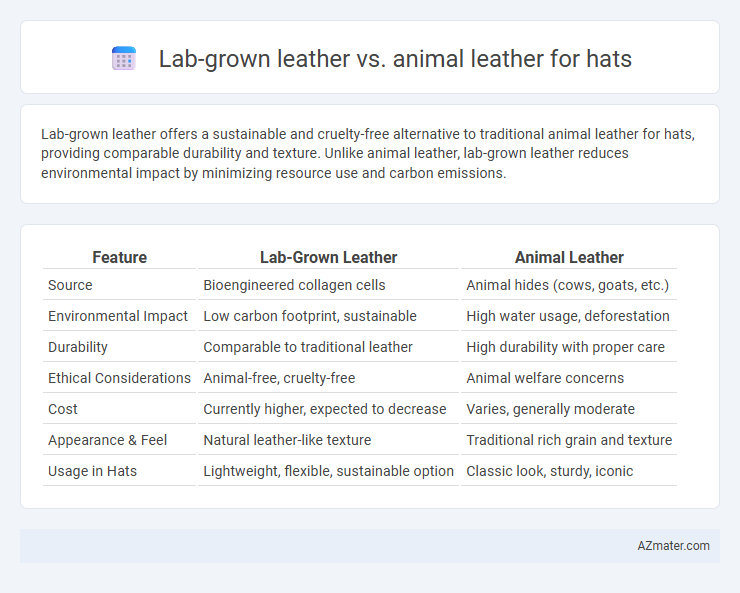Lab-grown leather offers a sustainable and cruelty-free alternative to traditional animal leather for hats, providing comparable durability and texture. Unlike animal leather, lab-grown leather reduces environmental impact by minimizing resource use and carbon emissions.
Table of Comparison
| Feature | Lab-Grown Leather | Animal Leather |
|---|---|---|
| Source | Bioengineered collagen cells | Animal hides (cows, goats, etc.) |
| Environmental Impact | Low carbon footprint, sustainable | High water usage, deforestation |
| Durability | Comparable to traditional leather | High durability with proper care |
| Ethical Considerations | Animal-free, cruelty-free | Animal welfare concerns |
| Cost | Currently higher, expected to decrease | Varies, generally moderate |
| Appearance & Feel | Natural leather-like texture | Traditional rich grain and texture |
| Usage in Hats | Lightweight, flexible, sustainable option | Classic look, sturdy, iconic |
Introduction: Lab-Grown Leather and Animal Leather for Hats
Lab-grown leather offers a sustainable alternative to traditional animal leather, produced through bioengineering cells to mimic the texture and durability needed for quality hats. Animal leather remains valued for its natural grain, strength, and breathability, essential characteristics in premium hat design. Comparing lab-grown and animal leather focuses on environmental impact, material properties, and consumer preferences in the hat industry.
Material Composition: Lab-Grown vs Animal Leather
Lab-grown leather for hats consists primarily of cultured collagen fibers created through cellular agriculture, offering consistent texture and reduced environmental impact compared to animal leather, which is derived from the tanned hides of cattle and contains natural variations in grain and thickness. The molecular structure of lab-grown leather mimics the durability and flexibility of animal leather while eliminating the presence of animal fats and proteins that influence traditional tanning processes. Material composition differences affect breathability, weight, and aging properties, making lab-grown leather an innovative alternative with customizable attributes tailored to hat manufacturing needs.
Environmental Impact of Leather Choices
Lab-grown leather for hats significantly reduces environmental impact by eliminating the need for animal farming, thereby decreasing greenhouse gas emissions, water consumption, and land use compared to traditional animal leather. Conventional leather production involves intensive resource use and pollution from tanning chemicals, contributing to soil and water contamination. Choosing lab-grown leather promotes sustainability by minimizing carbon footprint and supporting eco-friendly manufacturing processes.
Durability and Longevity of Leather Hats
Lab-grown leather offers enhanced durability and consistent quality for leather hats, resisting wear and tear better than traditional animal leather. Animal leather, while naturally robust, varies in strength and may develop cracks over time without proper maintenance. Advancements in lab-grown leather technology aim to extend the longevity of leather hats by providing water resistance and flexibility unmatched by conventional leather.
Comfort and Breathability in Hat Materials
Lab-grown leather offers enhanced breathability and moisture-wicking properties compared to traditional animal leather, improving overall comfort in hat materials. Its consistent texture reduces stiffness and allows for better ventilation, which minimizes heat buildup and sweating during extended wear. Animal leather provides durability but often lacks the same level of breathability, leading to reduced airflow and less comfort in hot or humid conditions.
Design Flexibility and Aesthetics
Lab-grown leather offers superior design flexibility for hats, allowing intricate textures and custom patterns unattainable with traditional animal leather. Its uniform surface quality enhances aesthetic consistency and enables vibrant color applications without compromising durability. Animal leather, while valued for its natural grain and patina, often limits design customization due to variability and processing constraints.
Ethical Considerations in Leather Production
Lab-grown leather significantly reduces animal suffering by eliminating the need for livestock farming and slaughter, addressing major ethical concerns in traditional leather production. It offers a cruelty-free alternative that also minimizes environmental impacts associated with animal agriculture, such as greenhouse gas emissions and deforestation. Ethical consumers increasingly prefer lab-grown leather for hats due to its alignment with animal welfare and sustainable production values.
Cost Comparison: Lab-Grown vs Animal Leather Hats
Lab-grown leather hats typically cost 10-30% more than traditional animal leather hats due to advanced manufacturing processes and smaller production scales. Animal leather benefits from established supply chains and economies of scale that reduce its overall price. However, lab-grown leather presents potential for significant cost reductions as technology advances and production volumes increase.
Consumer Perception and Market Trends
Consumer perception of lab-grown leather for hats is rapidly shifting due to heightened awareness of sustainability and animal welfare, with increasing preference for eco-friendly and cruelty-free alternatives. Market trends indicate a significant rise in demand for lab-grown leather products, driven by advancements in technology that improve texture and durability while maintaining competitive pricing. Traditional animal leather remains favored for its established heritage and natural characteristics, but younger, ethically-conscious consumers are increasingly influencing market dynamics toward lab-grown options.
Future Prospects for Leather Hats
Lab-grown leather offers sustainable advantages for hat manufacturing by reducing environmental impact and ethical concerns associated with animal leather. Innovations in biotechnology enable lab-grown leather to mimic the durability, flexibility, and aesthetic qualities of traditional animal leather, making it a viable material for premium hats. As consumer demand shifts towards eco-friendly fashion, lab-grown leather is poised to capture a significant market share in the future of luxury and everyday leather hats.

Infographic: Lab-grown leather vs Animal leather for Hat
 azmater.com
azmater.com